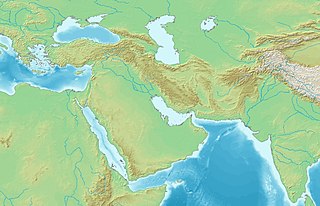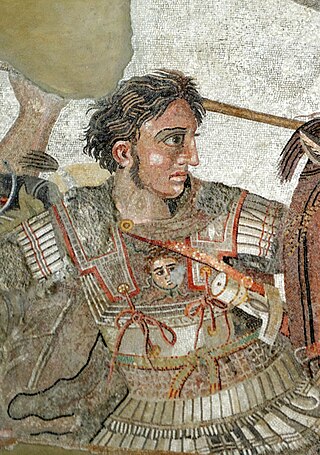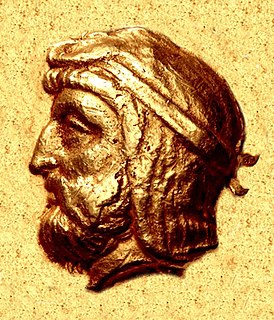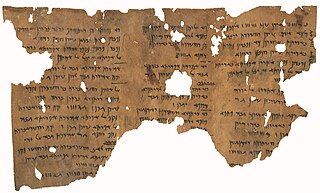Related Research Articles

Bactria, or Bactriana, was an ancient region in Central Asia. Bactria proper was north of the Hindu Kush mountain range and south of the Oxus river, covering the flat region that straddles modern-day Afghanistan. More broadly, Bactria was the area which was located north of the Hindu Kush, west of the Pamirs and south of the Tian Shan, covering modern-day Tajikistan and Uzbekistan as well, with the Amu Darya flowing west through the centre.

Darius III was the last Achaemenid King of Kings of Persia, reigning from 336 BC to his death in 330 BC.
This article concerns the period 339 BC – 330 BC.

This article concerns the period 329 BC – 320 BC.
Year 330 BC was a year of the pre-Julian Roman calendar. At the time, it was known as the Year of the Consulship of Crassus and Venno. The denomination 330 BC for this year has been used since the early medieval period, when the Anno Domini calendar era became the prevalent method in Europe for naming years.
Bessus, also known by his throne name Artaxerxes V, was a prominent Persian satrap of Bactria in Persia, and later self-proclaimed king of Persia. According to classical sources, he killed his predecessor and relative, Darius III, after the Persian army had been defeated by Alexander the Great. Greek scholars wrote his name as Βῆσσος.
Artabazos was a Persian general in the army of Xerxes I, and later satrap of Hellespontine Phrygia under the Achaemenid dynasty, founder of the Pharnacid dynasty of satraps. He was the son of Pharnaces, who was the younger brother of Hystaspes, father of Darius I. Artabazos was therefore a first cousin of the great Achaemenid ruler Darius I.

The wars of Alexander the Great were a series of wars, fought over a span of thirteen years, that were carried out by King Alexander III of Macedon. The wars began with the battles against the Achaemenid Persian Empire under the rule of former King Darius III. After Alexander's chain of victories against Persia, he then began to skirmish with local chieftains and warlords stretching as far as modern-day Punjab, India. By the time of his death, he was emperor over most regions of Greek culture and the conquered Persian Empire. He did not manage to conquer all of South Asia as was his initial plan. Although he was a very successful military commander, he did not provide any stable alternative to the Achaemenid Empire, and his untimely death threw the vast territories he conquered into civil war.

Balkh is one of the 34 provinces of Afghanistan, located in the north of the country. It is divided into 15 districts and has a population of about 1,509,183, which is multi-ethnic and mostly a Persian-speaking society. The city of Mazar-i-Sharif serves as the capital of the province. The Mazar-e Sharif International Airport and Camp Marmal sit on the eastern edge of Mazar-i-Sharif.

Alexandria Eschate was a city founded by Alexander the Great, at the south-western end of the Fergana Valley in August 329 BCE. It was the most northerly outpost of Alexander's Empire in Central Asia. Alexandria Eschate was established on the south bank of the river Jaxartes, at or close to the site of modern Khujand.

Dayuan is the Chinese exonym for a country that existed in Ferghana valley in Central Asia, described in the Chinese historical works of Records of the Grand Historian and the Book of Han. It is mentioned in the accounts of the Chinese explorer Zhang Qian in 130 BCE and the numerous embassies that followed him into Central Asia. The country of Dayuan is generally accepted as relating to the Ferghana Valley, controlled by the Greek polis Alexandria Eschate, which can probably be understood as "Greco-Fergana city-state" in English language.

Margiana is a historical region centred on the oasis of Merv and was a minor satrapy within the Achaemenid satrapy of Bactria, and a province within its successors, the Seleucid, Parthian and Sasanian empires.
Spitamenes was a Sogdian warlord and the leader of the uprising in Sogdiana and Bactria against Alexander the Great, King of Macedon, in 329 BC. He has been credited by modern historians as one of the most tenacious adversaries of Alexander.

Oxyartes was a Sogdian or Bactrian nobleman of Bactria, father of Roxana, the wife of Alexander of Macedon.

Artabazos II was a Persian general and satrap of Hellespontine Phrygia. He was the son of the Persian satrap of Hellespontine Phrygia Pharnabazus II, and younger kinsman of Ariobarzanes of Phrygia who revolted against Artaxerxes II around 356 BC. His first wife was an unnamed Greek woman from Rhodes, sister of the two mercenaries Mentor of Rhodes and Memnon of Rhodes. Towards the end of his life, he became satrap of Bactria for Alexander the Great.

Aria is an Achaemenid region centered on the city of Herat in present-day western Afghanistan. In classical sources, Aria has been several times confused with the greater region of ancient Ariana, of which Aria formed a part.

The Bactrian Kingdom, known to historians as the Greco-Bactrian Kingdom, was a Hellenistic-era Greek state, and along with the Indo-Greek Kingdom, the easternmost part of the Hellenistic world in Central Asia and the Indian Subcontinent from its founding in 256 BC by Diodotus I Soter to its fall c.120-100 BC under the reign of Heliocles II. It covered much of present-day Afghanistan, Uzbekistan, Tajikistan and Turkmenistan, and at its zenith, parts of Iran, Pakistan. Bactria was ruled by the Diodotid dynasty and rival Euthydemid dynasty. The capitals of Ai-Khanum and Bactra were among the largest and richest of antiquity - Bactria itself was known as the ‘land of a thousand golden cities’. The Indo-Greek Kingdoms, as Bactrian successor states, would last until 10 AD.

The Achaemenid Empire, also called the First Persian Empire, was an ancient Iranian empire that was based in Western Asia and founded by Cyrus the Great in 550 BC. It reached its greatest extent under Xerxes I, who conquered most of northern and central ancient Greece, including the city of Athens, in 480 BC. At its greatest territorial extent, the Achaemenid Empire stretched from the Balkans and Eastern Europe in the west to the Indus Valley in the east. The empire was larger than any previous empire in history, spanning a total of 5.5 million square kilometers.

The Thirty-first Dynasty of Egypt, also known as the Second Egyptian Satrapy, was effectively a satrapy of the Achaemenid Persian Empire between 343 BC to 332 BC. It was founded by Artaxerxes III, the King of Persia, after his reconquest of Egypt and subsequent crowning as Pharaoh of Egypt, and was disestablished upon the conquest of Egypt by Alexander the Great.

The Khalili Collection of Aramaic Documents is a private collection of letters and documents from the Bactria region in present-day Afghanistan, assembled by the British-Iranian collector and philanthropist Nasser D. Khalili. It is one of the Khalili Collections: eight collections of artifacts assembled, conserved, published and exhibited by Khalili.
References
- ↑ Smith, Vincent A. (1908) The Early History of India, p. 45. Oxford. The Clarendon Press.